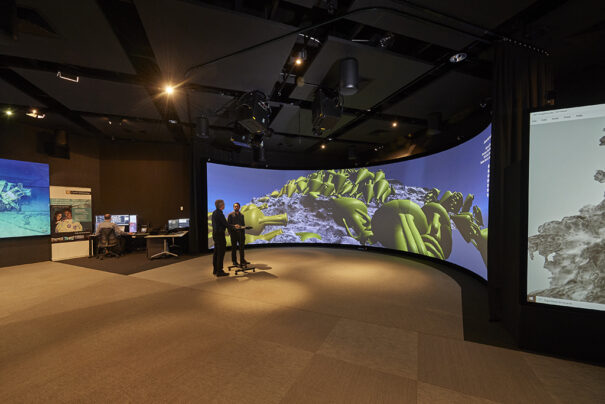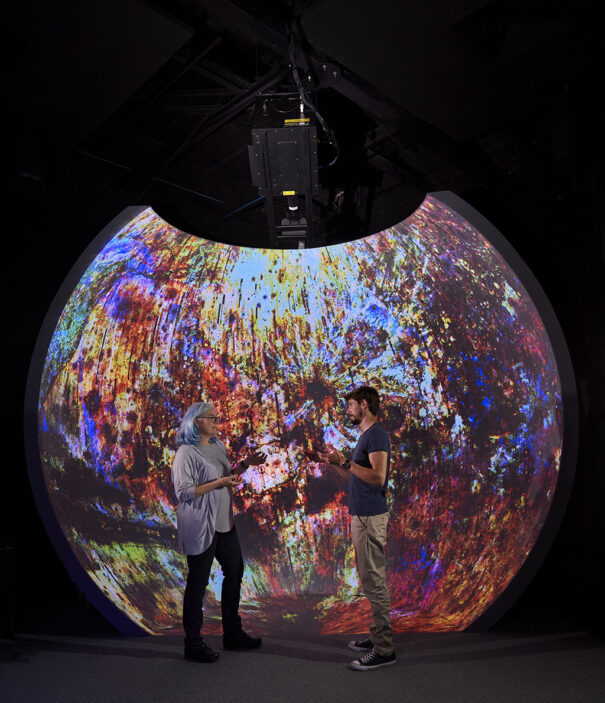Digital Projection Performs First Installation with MLS Projection at HIVE
The Immersive Visualization and Electronic Research Center (HIVE) of the Curtin University has upgraded its Dome and Cylinder displays with Satellite Modular Laser System projectors (MLS) of Digital Projection.
The Immersive Visualization and Electronic Research Center (HIVE) of the Curtin University (Perth – Western Australia) Support research, Pioneering space exploration, Health Sciences, Education and engineering. Recently, has set another milestone with the world's first installation of projectors Satellite Modular Laser System (MLS) of Digital Projection.
The HIVE is one of the most advanced display facilities of its kind and the only one to feature five different large-scale displays. Her work with technologies such as virtual and augmented reality, Data Visualization and Scientific, 3D photogrammetric reconstruction and volumetric imaging, have been used to help patients with spinal cord injuries, Investigate consumer behavior and create virtual experiences of shipwreck locations.
"First of all, It's a safe environment (sandbox) which offers the opportunity to explore a wide range of options in visualization technology for research projects in all areas of expertise. The facilities were created in 2013, so it was time to upgrade their AV systems with the latest projection technology.", Explains Andrew Woods, Associate Professor and Manager of the HIVE at Curtin University.
The HIVE Viewing Facilities, located in an old exhibition space of 15×15 metre, comprise five types of display configurations: Dome, Cylinder, Wedge, Tiled and Hologram Table.
Dome is a half-dome screen with 4 meters in diameter, that fills the user's primary and peripheral field of vision. Cylinder is an immersive 3D that offers a virtual reality experience for up to 50 Users. Wedge consists of a pair of 3D screens of 3,8 diagonal meters which is mainly used for scientific visualization. Tiled features a resolution of 24 MP and is used for very high resolution images. And Hologram Table offers two users 3D images that are projected from the surface of a table. The upgrade project focused on the Dome and Cylinder screens.
"In the HIVE, Cylinder is the star system of the installation. Use three projectors to illuminate a 180º cylindrical projection screen of 3 meters high by 8 diameter. With its update, we wanted to increase its resolution to use native 4K projectors, which would provide a quadrupling of the displayed pixels, and increase brightness. All without compromising the stereoscopic 3D capability of 120 Hz offered by the screen", Woods clarifies.
After speaking with Digital Projection, The InDesign Technologies, Project Consultant, understood that Digital Projection's Satellite MLS solution was the projection system that met the requirements of the HIVE (4K complete with compatibility of 120 Hz, and without being subject to the exclusion zones that would be required with a class laser product 3).
"Digital Projection's MLS was still under development as a technology when the talks began", recalls Tanya Hall, Business Development Manager of Integrated Solutions at Amber Technology, Digital Projection distributor in Australia and New Zealand.
Hall collaborated with Woods, InDesign, The integrator Vizcom Technologies and Emilijo Mihatov, Regional Sales Director Digital Projection, to discuss and outline the technological requirements of the project, and with Vioso to develop a solution that would adapt to the installation requirements of the HIVE Cylinder screen.
The MLS separates the light source from the small, lightweight projector head, Offering more freedom to integrators, especially when space and access are limited, while reducing noise and heat in the audience area. This technology makes high-end RGB laser lighting accessible for any budget.
In the HIVE, three Satellite MLS systems have been installed on the Cylinder display, and another one in the Dome. Taking advantage of the modular nature of these projectors, that allow a separation of up to 100 meters between the projection head and the light source, InDesign was able to hang the heads of the satellite projectors in the exhibition spaces, while the light sources were placed at about 15 meters away in a server room that houses the rest of the audiovisual and computer equipment.
"It was important that the projectors had as little sound impact as possible on the space", clarifies Scott Wrightson, Project Manager at Vizcom Technologies. "This made Satellite MLS systems a must-have. By having the main laser processor housed in the central communications room, the operating noise level of the heads was very low, which was ideal for this project".
Working with such a novel technology came with certain challenges. Projectors required special lenses that, at that time, they did not have any local distributor, but with the help of Emilijo Mihatov of Digital Projection, Amber Technology was able to contact the lens manufacturer and establish a commercial agreement to bring them to Australia.
In the same way, with the sophisticated mixing requirements for the cylindrical component of the project, Amber was able to get in touch with Vioso through Digital Projection and get the mixing stations you needed.
Physical mounting positions also proved to be an issue, Wrightson recalls, as a complete structural reinforcement was necessary to get the mounting beams in the correct positions for the Cylinder and Dome screens.
"With this mounting solution, there were also some ambient vibrations coming from the building's HVAC and ventilation systems", Wrightson continues, "which was especially noticeable when using the Jenoptik fisheye lens in the Dome screen area, so we had to design and build a custom lens neck to cancel them out.".
For HIVE, The improvement of the audiovisual system is an important step forward for a facility whose work revolves around high-impact images. "Ultimately, our goal is to make the HIVE screens essentially invisible to the user, and merely offer a window into a different world", Woods adds. "Our goal is to put incredible images on the blank canvas of these screens, that support our users' applications and research projects".
You liked this article?
Subscribe to our Feed And you won't miss a thing.
• Section: Case Studies, OUTSTANDING, Digital signage, Display, Formation, Projection, Augmented reality, Simulation





















